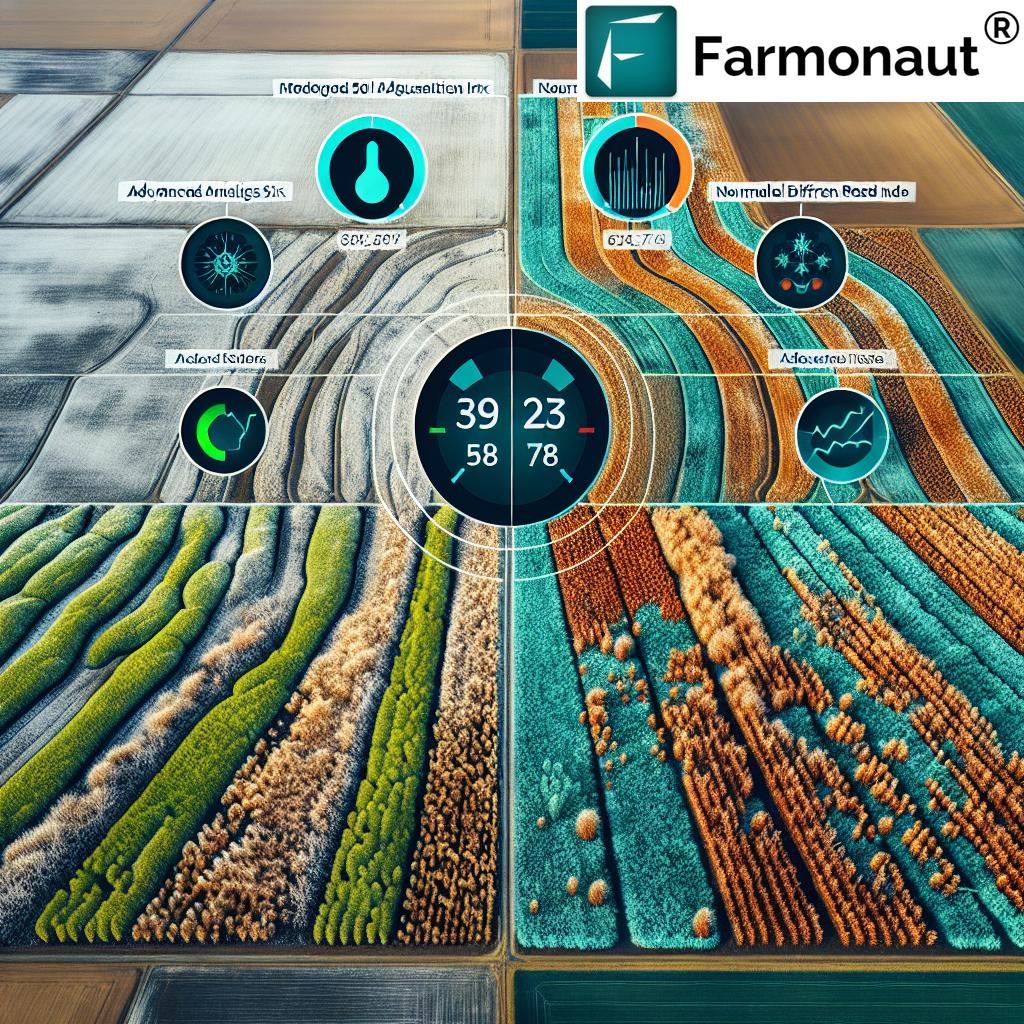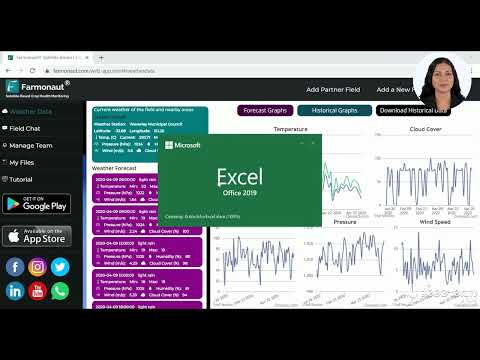Frost-Proof Your Crops: A Farmer’s Guide to Satellite Monitoring and Prevention Techniques

“Satellite monitoring can detect frost damage signs using up to 5 different vegetation indices, including MSAVI and NDRE.”
Welcome to our comprehensive guide on frost-proofing your crops using cutting-edge satellite monitoring and prevention techniques. As farmers, we understand the devastating impact frost damage can have on our harvests. In this blog post, we’ll explore how to leverage advanced agricultural analytics and precision agriculture methods to combat frost-related challenges effectively. Let’s dive into the world of satellite crop monitoring and discover how it can revolutionize our approach to frost damage prevention in crops.
Understanding Frost Damage and Its Impact on Agriculture
Frost damage is a significant concern for farmers worldwide, capable of causing substantial losses in crop yield and quality. As temperatures drop below freezing, ice crystals form within plant cells, disrupting their structure and function. This can lead to wilting, browning, and even plant death in severe cases. The impact of frost on agriculture is far-reaching, affecting not only individual farmers but also food suppliers and the broader agricultural industry.
- Crop losses due to frost can result in reduced yields and financial setbacks
- Frost damage can affect crop quality, leading to lower market prices
- Entire growing seasons can be compromised by severe frost events
To combat these challenges, we need to adopt innovative approaches that combine traditional agricultural practices with modern technology. This is where satellite crop monitoring and precision agriculture techniques come into play.
The Power of Satellite Crop Monitoring in Frost Prevention
Satellite crop monitoring has emerged as a game-changer in modern agriculture, offering farmers unprecedented insights into their fields’ conditions. By harnessing the power of remote sensing and advanced analytics, we can now detect early signs of frost damage and take proactive measures to protect our crops.
Key benefits of satellite crop monitoring for frost prevention:
- Real-time monitoring of crop health and field conditions
- Early detection of frost-prone areas within fields
- Precise mapping of crop damage after frost events
- Data-driven decision-making for implementing prevention strategies
Farmonaut’s satellite-based crop health monitoring system utilizes multispectral satellite images to provide farmers with crucial insights into vegetation health, soil moisture levels, and other vital metrics. This data empowers us to make informed decisions about irrigation, fertilizer usage, and frost prevention strategies.
Leveraging Vegetation Indices for Frost Damage Assessment
Vegetation indices are powerful tools in our arsenal for assessing crop health and detecting frost damage. These indices use specific bands of the electromagnetic spectrum to provide valuable information about plant vigor and stress levels. Two particularly useful indices for frost damage assessment are MSAVI (Modified Soil Adjusted Vegetation Index) and NDRE (Normalized Difference Red Edge).
- MSAVI: This index is particularly effective in areas with sparse vegetation, making it ideal for early-season frost monitoring.
- NDRE: NDRE is sensitive to changes in chlorophyll content, allowing for the detection of subtle stress signs that may indicate frost damage.
By incorporating these vegetation indices into our monitoring strategies, we can identify potential frost damage before it becomes visually apparent, allowing for timely intervention.
Precision Agriculture Techniques for Frost Mitigation
Precision agriculture is revolutionizing the way we approach frost prevention. By combining satellite data with on-ground sensors and advanced analytics, we can implement targeted strategies to protect our crops from freezing temperatures.
Key precision agriculture techniques for frost mitigation:
- Variable-rate irrigation systems for targeted frost protection
- Automated frost alarms based on real-time temperature monitoring
- Precision application of frost-protection products
- Microclimate mapping for optimized planting strategies
These techniques allow us to allocate resources efficiently, focusing our efforts on the most vulnerable areas of our fields. By leveraging precision agriculture, we can significantly reduce the risk of frost damage while optimizing our use of water, energy, and protective materials.
Explore Farmonaut’s API for custom precision agriculture solutions
Historical Weather Data Analysis: A Key to Proactive Frost Prevention
“Historical weather data analysis can improve frost prevention strategies by up to 30% through optimized planting schedules and variety selection.”
Understanding past weather patterns is crucial for developing effective frost prevention strategies. By analyzing historical weather data, we can identify frost-prone periods, optimize our planting schedules, and select crop varieties best suited to our local climate conditions.
- Identify frost-prone periods in your specific region
- Optimize planting dates to minimize frost risk
- Select frost-resistant crop varieties based on historical data
- Develop long-term frost prevention strategies
Farmonaut’s platform provides access to comprehensive historical weather data, enabling farmers to make data-driven decisions about their frost prevention strategies. By combining this historical insight with real-time satellite monitoring, we can create a robust defense against frost damage.
Practical Frost Prevention Techniques for Farmers
While satellite monitoring and data analysis provide invaluable insights, it’s essential to complement these technologies with practical on-ground techniques. Let’s explore some effective methods for protecting our crops from frost damage:
1. Water Spraying
One of the most common and effective frost prevention techniques is water spraying. As water freezes, it releases latent heat, which can help protect plants from frost damage.
- Use overhead irrigation systems to create a protective layer of ice
- Start spraying before temperatures reach freezing point
- Continue spraying until ice begins to melt in the morning
2. Antitranspirants
Antitranspirants are substances applied to plants to reduce water loss through transpiration. They can also provide a degree of frost protection by creating a protective film on plant surfaces.
- Apply antitranspirants before expected frost events
- Choose products specifically designed for frost protection
- Reapply as needed, following manufacturer guidelines
3. Frost-Resistant Crop Varieties
Selecting frost-resistant crop varieties is a proactive approach to minimizing frost damage risk. These varieties are bred to withstand colder temperatures and recover more quickly from frost events.
- Research frost-resistant varieties suitable for your region
- Consider factors such as yield potential and market demand
- Integrate resistant varieties into your crop rotation plan
4. Wind Machines
Wind machines can help prevent frost damage by mixing warmer air from above with colder air near the ground, creating a temperature inversion.
- Install wind machines strategically in frost-prone areas
- Operate machines when temperature inversions are present
- Use in combination with other frost prevention methods for best results
Access Farmonaut’s API Developer Docs for advanced integration options
Integrating Satellite Monitoring with On-Ground Techniques
The true power of frost prevention lies in integrating satellite monitoring with on-ground techniques. By combining these approaches, we can create a comprehensive frost protection strategy that leverages both technological insights and practical methods.
Steps for integration:
- Use satellite data to identify frost-prone areas in your fields
- Deploy targeted frost prevention techniques in high-risk zones
- Monitor real-time temperature data to trigger automated responses
- Assess the effectiveness of prevention methods using post-frost satellite imagery
- Refine your strategy based on ongoing data analysis and field observations
This integrated approach allows us to maximize the efficiency of our frost prevention efforts while minimizing resource use and environmental impact.
Advanced Agricultural Analytics for Frost Risk Assessment
Advanced agricultural analytics play a crucial role in assessing and mitigating frost risk. By leveraging machine learning algorithms and big data analysis, we can develop predictive models that forecast frost events with increasing accuracy.
- Develop frost risk maps based on topography, soil type, and microclimate data
- Create custom alerts for potential frost events
- Analyze crop growth stages to identify periods of heightened frost sensitivity
- Integrate weather forecast data for proactive decision-making
Farmonaut’s Jeevn AI Advisory System utilizes these advanced analytics to provide personalized farm advisory services, including frost risk assessments and prevention recommendations.
Remote Crop Damage Assessment Using Satellite Imagery
In the unfortunate event of frost damage, rapid assessment is crucial for making informed decisions about crop management and potential insurance claims. Satellite imagery provides an efficient and accurate method for remote crop damage assessment.
Benefits of satellite-based damage assessment:
- Quickly assess large areas without the need for extensive field visits
- Create detailed damage maps for targeted recovery efforts
- Provide objective data for insurance claims and loss adjustment
- Monitor crop recovery over time
By utilizing Farmonaut’s satellite crop monitoring services, farmers can quickly assess the extent of frost damage and make data-driven decisions about crop management and potential replanting.
Climate-Smart Farming Practices for Long-Term Frost Resilience
Building long-term resilience against frost damage requires adopting climate-smart farming practices. These approaches focus on enhancing overall crop resilience while reducing vulnerability to extreme weather events, including frost.
- Implement conservation tillage to improve soil health and moisture retention
- Use cover crops to protect soil and enhance organic matter content
- Diversify crop rotations to spread risk across different crop types
- Invest in agroforestry systems to create natural windbreaks and microclimates
By integrating these practices with satellite monitoring and precision agriculture techniques, we can create a holistic approach to frost prevention that enhances overall farm sustainability and resilience.
The Role of Geospatial Intelligence in Frost Prevention
Geospatial intelligence is revolutionizing agricultural production, particularly in the realm of frost prevention. By combining satellite imagery, GPS data, and advanced mapping technologies, we can create highly detailed and actionable insights for frost mitigation.
Applications of geospatial intelligence in frost prevention:
- Create high-resolution frost risk maps based on terrain and microclimate data
- Optimize placement of frost prevention equipment such as wind machines and sprinklers
- Develop precision planting strategies that account for frost-prone areas
- Monitor crop development stages across different field zones for targeted protection
Farmonaut’s platform leverages geospatial intelligence to provide farmers with comprehensive field insights, enabling more effective frost prevention strategies and overall farm management.
Comparison of Frost Prevention Techniques
| Prevention Technique | Effectiveness | Cost | Implementation Complexity | Satellite Monitoring Compatibility |
|---|---|---|---|---|
| Water Spraying | High | Medium | Moderate | Yes |
| Antitranspirants | Medium | Low | Easy | Yes |
| Frost-resistant Varieties | High | Medium | Easy | Yes |
| Historical Weather Data Analysis | Medium | Low | Moderate | Yes |
| Satellite Crop Monitoring | High | Medium | Moderate | Yes |
Future Trends in Frost Prevention Technology
As technology continues to advance, we can expect to see exciting developments in frost prevention techniques. Some emerging trends to watch include:
- Integration of IoT sensors for real-time, hyper-local temperature monitoring
- AI-powered frost prediction models with increased accuracy and lead time
- Autonomous frost protection systems that react to changing conditions
- Development of new, environmentally friendly frost protection materials
Staying informed about these trends and adopting new technologies as they become available will be crucial for maintaining a competitive edge in frost prevention.
Conclusion: Empowering Farmers with Satellite-Based Frost Prevention
Frost damage prevention in crops is a complex challenge that requires a multifaceted approach. By leveraging satellite crop monitoring, precision agriculture techniques, and advanced agricultural analytics, we can significantly enhance our ability to protect our harvests from frost damage.
Farmonaut’s comprehensive platform offers farmers the tools they need to implement effective frost prevention strategies, from real-time crop health monitoring to AI-driven advisory services. By combining these technological solutions with traditional agricultural practices and climate-smart farming techniques, we can build resilient farming systems capable of withstanding the challenges posed by frost and other extreme weather events.
As we continue to face the uncertainties of a changing climate, the integration of satellite-based solutions into our frost prevention strategies will become increasingly crucial. By embracing these technologies and staying informed about the latest developments in agricultural science, we can ensure the long-term sustainability and productivity of our farms.

FAQs
- Q: How accurate is satellite monitoring in detecting frost damage?
A: Satellite monitoring can be highly accurate in detecting frost damage, especially when using multiple vegetation indices like MSAVI and NDRE. These indices can detect subtle changes in plant health before visual symptoms appear. - Q: Can satellite monitoring prevent all frost damage?
A: While satellite monitoring is a powerful tool, it cannot prevent all frost damage. It helps in early detection and informed decision-making, but should be used in conjunction with on-ground prevention techniques for best results. - Q: How often should I monitor my fields using satellite imagery?
A: The frequency of monitoring depends on your crop type and local climate. During high-risk periods, daily monitoring is recommended. Farmonaut’s platform offers flexible monitoring options to suit different needs. - Q: Is satellite-based crop monitoring expensive?
A: Farmonaut offers cost-effective satellite monitoring solutions that are accessible to farmers of all scales. The potential savings from prevented crop losses often outweigh the investment in monitoring services. - Q: Can I integrate Farmonaut’s data with my existing farm management software?
A: Yes, Farmonaut provides API access that allows integration with various farm management software systems. This enables seamless incorporation of satellite data into your existing workflows.






